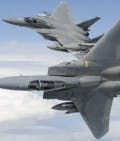Multispectral imaging, miniaturization, and improved image resolution eyed by infrared sensor designers
Designers of infrared sensors for aerospace and defense applications are concentrating their research efforts on blending IR sensors with electro-optical sensors for multispectral imaging, improving the resolution of IR sensors to match those of visible-light sensors, blending IR sensors with laser range finders, and shrinking the size of IR sensor packages for unmanned vehicles and other miniature applications.
"It really boils down to multispectral imaging," says Dave Strong, vice president of marketing at the FLIR Systems Government Systems Division in Wilsonville, Ore. Military IR sensor designers, Strong says, are trying to blend the most useful aspects of shortwave infrared (SWIR), midwave infrared (MWIR), and longwave infrared (LWIR) to improve surveillance, reconnaissance, and detection capability.
The idea is to take advantage of the strengths of different IR sensors, Strong explains. SWIR sensors, for example, can detect dirt that has been recently turned over, can differentiate between natural foliage and camouflage, can see through glass windows, and has sufficient resolution and detail to recognize human faces.
MWIR and LWIR sensors, meanwhile, can see in total darkness, while SWIR cannot. "If you have these technologies at your fingertips, you can do multispectral imaging," Strong says. "When you compare SWIR to the MWIR and LWIR bandwidth, you can highlight things that weren't apparent before."
Using data-fusion software algorithms to blend outputs from different IR sensors "is a multiplier in capability, and is bigger than the sum of its parts," explains John Antoniades, director of the ISR Exploitation Technologies Group at the BAE Systems Technology Solutions business unit in Columbia, Md.
Antoniades heads up a team that has developed the Autonomous Real-time Ground Ubiquitous Surveillance-Imaging System (ARGUS-IS), which will provide the persistent-surveillance payload for the A160T Hummingbird unmanned helicopter.
Although the ARGUS-IS system is a visible-light sensor system, designers and potential military users are figuring out how to blend the ARGUS-IS sensor data with outputs from infrared sensors such as the future Autonomous Real-time Ground Ubiquitous Surveillance-Infrared (ARGUS-IS) system for 24-hour persistent surveillance capability.
The ARGUS-IS, ARGUS-IR, and A160T unmanned aerial vehicle programs are under supervision of the U.S. Defense Advanced Research Projects Agency (DARPA) in Arlington, Va.
"A lot of work will have to go into the IR focal planes, which lag in the number of pixels they have, compared to the daytime electro-optical sensors," Antoniades says. The pixels in today's IR focal plane array sensors are also much larger than the electro-optical sensors. There is really a lot of infrared research going into shrinking the pixel size, and putting more pixels on the sensors, to fill the gap between the IR and EO sensors."
In other IR sensor trends, developers also are looking into blending IR sensors and laser target designators in very small packages "to make every sensor a shooter," Strong says. Following similar trends, developers are also trying to shrink the sizes of IR sensors to fit them on small unmanned vehicles.
Finally, IR sensor designers are looking to improve the resolution of their detectors to follow trends in high-definition (HD) imaging to improve definition and enable IR images to be shown on a growing number of displays.
Infrared and other optical sensor suppliers
Axsys Technologies -- a division of General Dynamics; Rocky Hill, Conn.; 860-257-0200; www.axsys.com
BAE Systems Electronic Solutions; Nashua, N.H.; 603-885-4321; www.baesystems.com
Clear Align; Eagleville, Pa.; 484-956-0510; www.clearalign.com
DRS Technologies RSTA; Palm Bay, Fla.; 321-308-4800; www.drs.com
FLIR Systems Inc.; Wilsonville, Ore.; 800-727-3547; www.flir.com
Lockheed Martin Missiles and Fire Control; Orlando, Fla.; 407-356-2000; www.lockheedmartin.com
ITT Night Vision and Imaging; Roanoke, Va.; 540-563-0371; www.nightvision.com
ITT Geospatial Systems; Rochester, N.Y.; 585-269-5600; www.ssd.itt.com
Kollsman, an Elbit Systems of America company; Merrimack, N.H.; 603-886-2080; www.kollsman.com
L-3 Infrared Products; Dallas; 972-528-1300; www.l-3com.com
Premier Electronics Ltd; Hoddesdon, England; 01992 478321; www.premierelect.co.uk
Princeton Lightwave; Cranbury, N.J.; 609-495-2600; www.princetonlightwave.com
Raytheon Vision Systems (RVS); Goleta, Calif.; 805-562-4292; www.raytheon.com
Sagem; Paris; + 33 (0)1 58 11 78 00; www.sagem-ds.com
Sensors Unlimited Inc.; Princeton, N.J.; 609-520-0610; www.sensorsinc.com
Sofradir EC; Fairfield, N.J.; 973-882-0211; www.sofradir-ec.com
Stanford Photonics Inc.; Palo Alto, Calif.; 650-969-5991; www.stanfordphotonics.com

